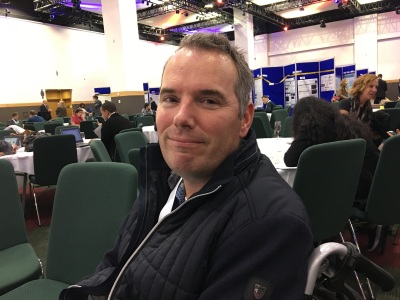Ask me anything about triple positive breast cancer. Most of the time, I will know the answer. I possess this seemingly random expertise because I have spent the last year making it my business to learn everything I possibly can about triple positive breast cancer in young women. I wanted to understand what was facing my sister as she entered her year of treatment.
What does breast cancer have to do with ALS? Nothing. (At least there is no as-of-yet identified link between the two conditions.) But my budding breast cancer expertise does have everything to do with my take-away from this year’s ALS/MND Symposium: Where were all of the patients and caregivers?
In addition to my personal experience, for my work at a health technology company, I participate in the “conference circuit”. Attending a wide array of conferences each year allows me to not only meet hundreds of researchers, advocates, and patients, but also to learn the differences in how researcher-advocate-patient triads operate across conditions.
Perhaps because of this experience, what struck me most at this year’s Symposium was the lack of advocate and patient perspectives included in the discussion. Some may argue: “Of course that was the case. This is an academic conference.” And while those with that view are not incorrect, I cannot help but wonder what we all missed by not having that voice more firmly in the room.
One of the most informative conversations I had during this year’s Symposium was with ALS Patient Jan Kramer. Jan traveled to the Symposium from The Netherlands with his brother-in-law, who served as his caregiver, in the role of patient advocate through ALS Patients Connected. Jan has an interesting take on patient engagement:

“You can only achieve [going in the right direction] if you include patients in everything which is going on about ALS and that means also include patients in conferences like these. Don’t think you should only have the so-called professional, because the most professional ALS people are the patients themselves.” – Jan Kramer
As Jan said, we have a lot to learn from patients and caregivers. These individuals are on the frontlines of battling the disease. They are the experts in how the disease is progressing, what new symptoms have emerged since the last visit, and how the condition is impacting the patient’s overall well-being.
Patients can also serve as pathways to innovation. Take, for example, the exciting new collaboration between Dr. Richard Bedlack and PatientsLikeMe, which seeks to find treatments and cures by looking across patient data and asking “what is working” instead of “what went wrong”.
Patients are our collaborators, not simply study subjects or participants. As Paul Wicks, VP of Innovation at PatientsLikeMe so nicely summarized in his Thursday afternoon presentation: “Patients are no more ours than we belong to the hotel we stay in tonight.”
Thus, I challenge us all to think about how we might better include the patient perspective and share out critical information at next year’s Symposium in Boston. Here are a few thoughts based on what I have seen at other gatherings:
- Have each presenter provide bullets of information that can be shared publicly and these bullets are shared out every night via the Symposium website.
- Implement a live streaming option for patients and caregivers who cannot afford to attend or for whom the logistics of travel prove too daunting. Allow these individuals to ask questions of the presenters.
- If a live stream is not possible, make the videos of the sessions available online after the conference (even for a fee).
- Include patient and caregiver voices in the presentation by increasing the percentage of these individuals on stage in any role – presenter, moderator, keynote.
- Incorporate more patient and caregiver quotes in presentations, when appropriate.
- Establish a scholarship fund to, at a minimum, cover the registration fee of caregivers who attend the conference to assist a patient.
Between now and Boston, I wonder: What can we do to make next year’s Symposium a more equitable exchange between collaborators?

“what struck me most at this year’s Symposium was the lack of advocate and patient perspectives included in the discussion” – as a former family caregiver my experiences at last year’s Symposium have been different. Both at the Allied Professionals Forum as well as within several sessions of the Symposium I followed presentations where patient and caregivers perspectives were included. Based upon my experiences as informal caregiver there have been presentations I just had to react and so I did in the following discussions. Sometimes critically but always with gratitude toward the researchers who brought issues on the floor which from my perspective are most important. My impression is that my voice has been heard. I did have esteeming informal discussions with professional caregivers and researchers. At lunchtime once my neighbour started a discussion by asking, so you are a former caregiver? I do not remember after which presentations, but patients did engage in discussions as well. I completely agree with all the other points and thoughts you raise in this Post.